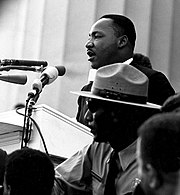The Big Six—Martin Luther King Jr., James Farmer, John Lewis, A. Philip Randolph, Roy Wilkins and Whitney Young—were the leaders of six prominent civil rights organizations who were instrumental in the organization of the March on Washington for Jobs and Freedom in 1963, at the height of the Civil Rights Movement in the United States.[1][2][3]
In his autobiography, Lay Bare the Heart (1985), James Farmer identified the term "Big Six" as having originated with the founding of the Council for United Civil Rights Leadership. He did not include A. Philip Randolph in his list of the "Big Six", instead listing Dorothy Height, president of the National Council of Negro Women as the sixth member of the group. He also noted that the press often referred to the group as the "Big Four", excluding Height and John Lewis, which he attributed to sexism and age bias, respectively.[4]
Patrick Henry Bass, journalist and historian of the March on Washington, described the rise of these leaders to celebrity: "Increasingly, these six powerful men lived in two worlds: the political and the personal, one white, in which they were still strangers but becoming increasingly familiar with its insider/outsider rules; the other, black, where they were treated as extended members of the family."[5]
About two months before the march, the Big Six broadened their organizing coalition by bringing on board four white men who supported their efforts: Walter Reuther, president of the United Automobile Workers; Eugene Carson Blake, former president of the National Council of Churches; Mathew Ahmann, executive director of the National Catholic Conference for Interracial Justice; and Joachim Prinz, president of the American Jewish Congress. Together, the Big Six plus the four newcomers became known as the "Big Ten".[6][7]
- ^ "The Big Six: John Lewis and His Contemporaries". Howard.edu. Retrieved February 5, 2013.
- ^ "Notable Achievements of Dr. Martin Luther King Jr". Wndu.com. Archived from the original on January 21, 2013. Retrieved February 5, 2013.
- ^ Lusted, Marcia Amidon (February 2013). "BIG SIX". Cobblestone. 34 (2): 16–21. ISSN 0199-5197 – via EBSCOHost.
- ^ Farmer, James (1985). Lay Bare the Heart. Fort Worth: Texas Christian University Press. p. 215. ISBN 9780875651880. Retrieved September 22, 2014.
- ^ Bass, Patrick Henry (2002). Like a Mighty Stream: The March on Washington, August 28, 1963. Philadelphia: Running Press. ISBN 0-7624-1292-5. p. 85.
- ^ Euchner, Charles C. (2010). Nobody turn me around: a people's history of the 1963 march on Washington. Boston: Beacon Press. ISBN 978-0-8070-0059-5. OCLC 441152928.
- ^ Thompson, Krissah (2013-08-25). "In March on Washington, white activists were largely overlooked but strategically essential". The Washington Post. ISSN 0190-8286. Retrieved 2020-07-31.
© MMXXIII Rich X Search. We shall prevail. All rights reserved. Rich X Search






